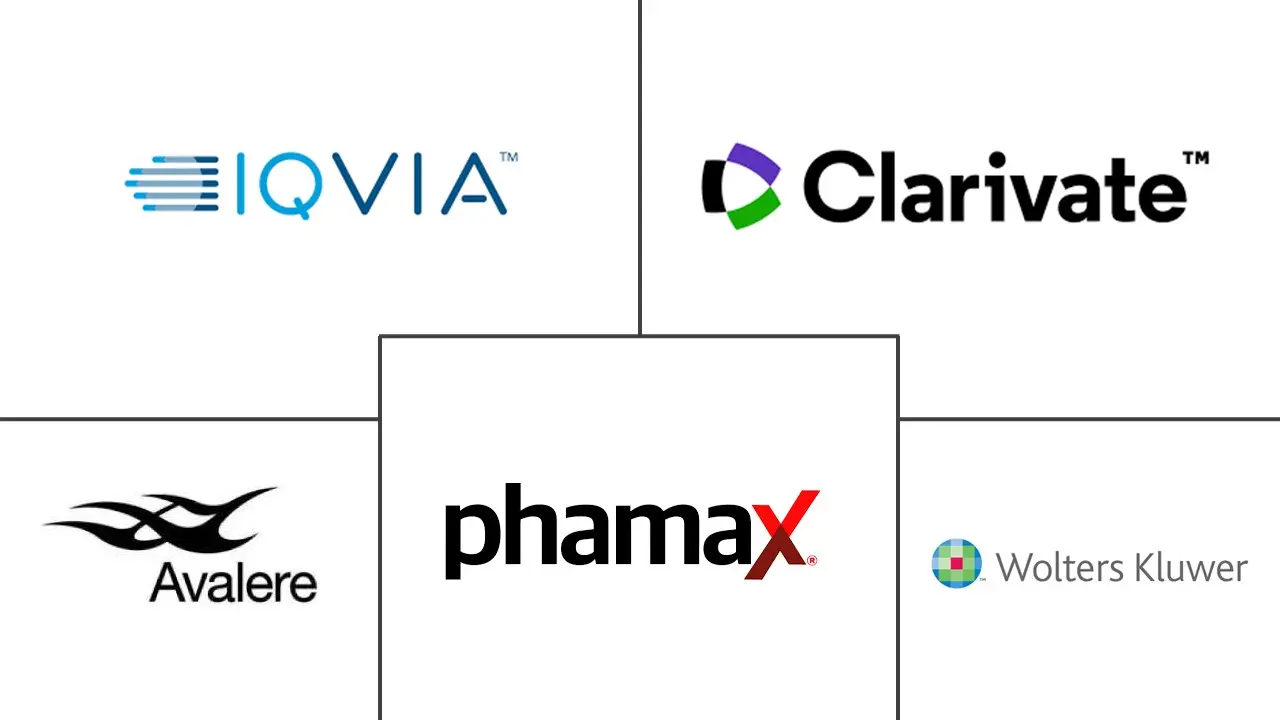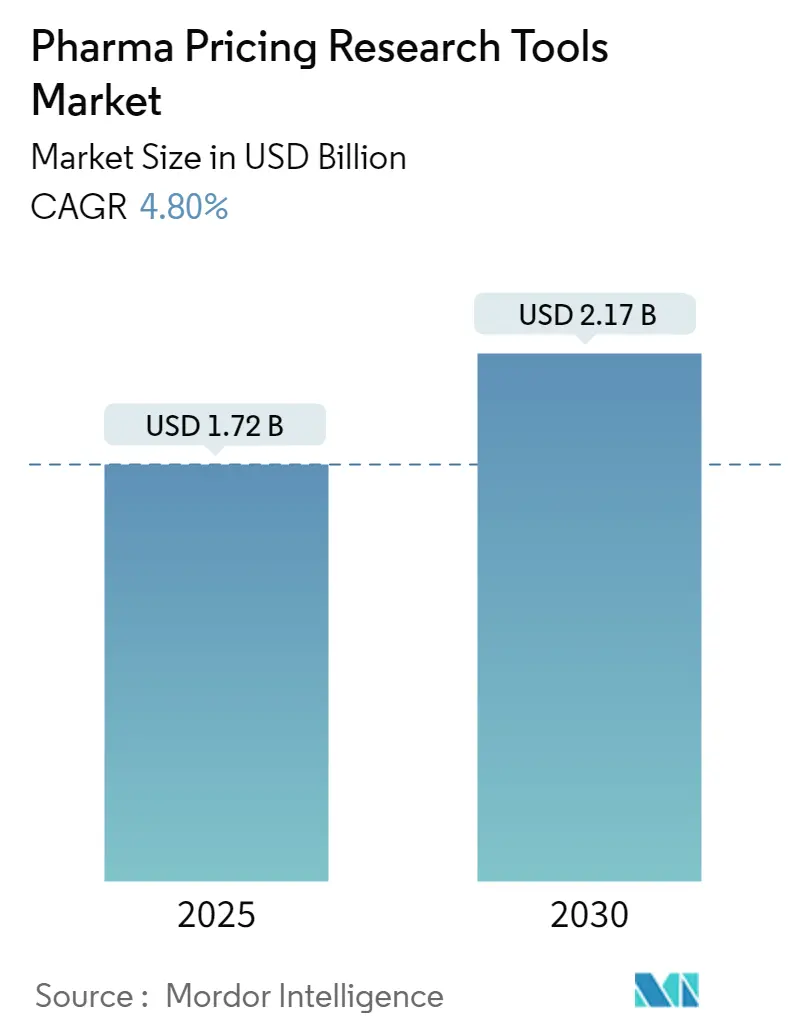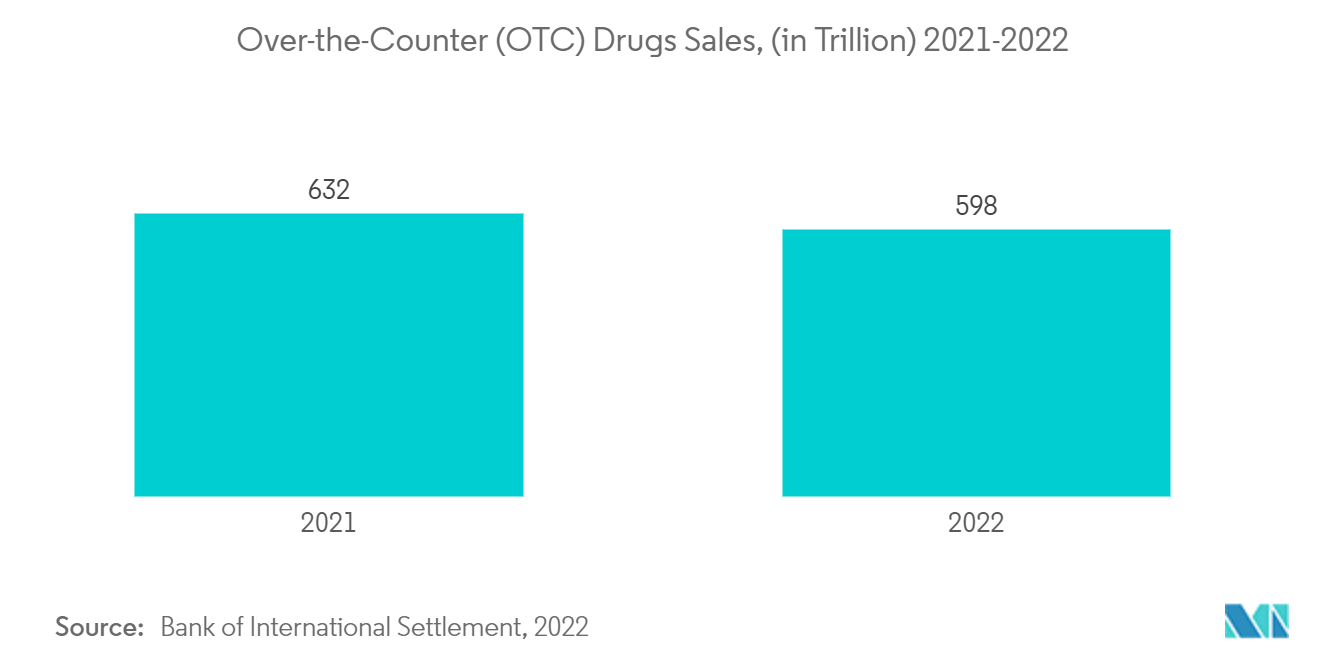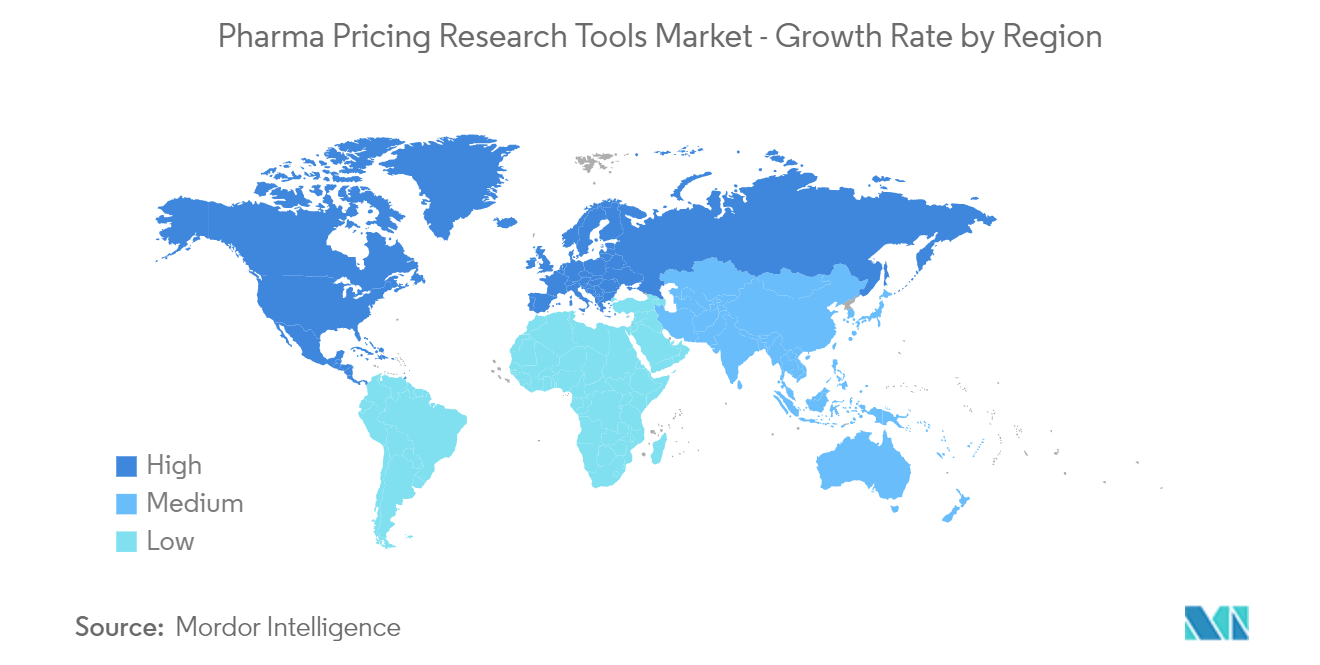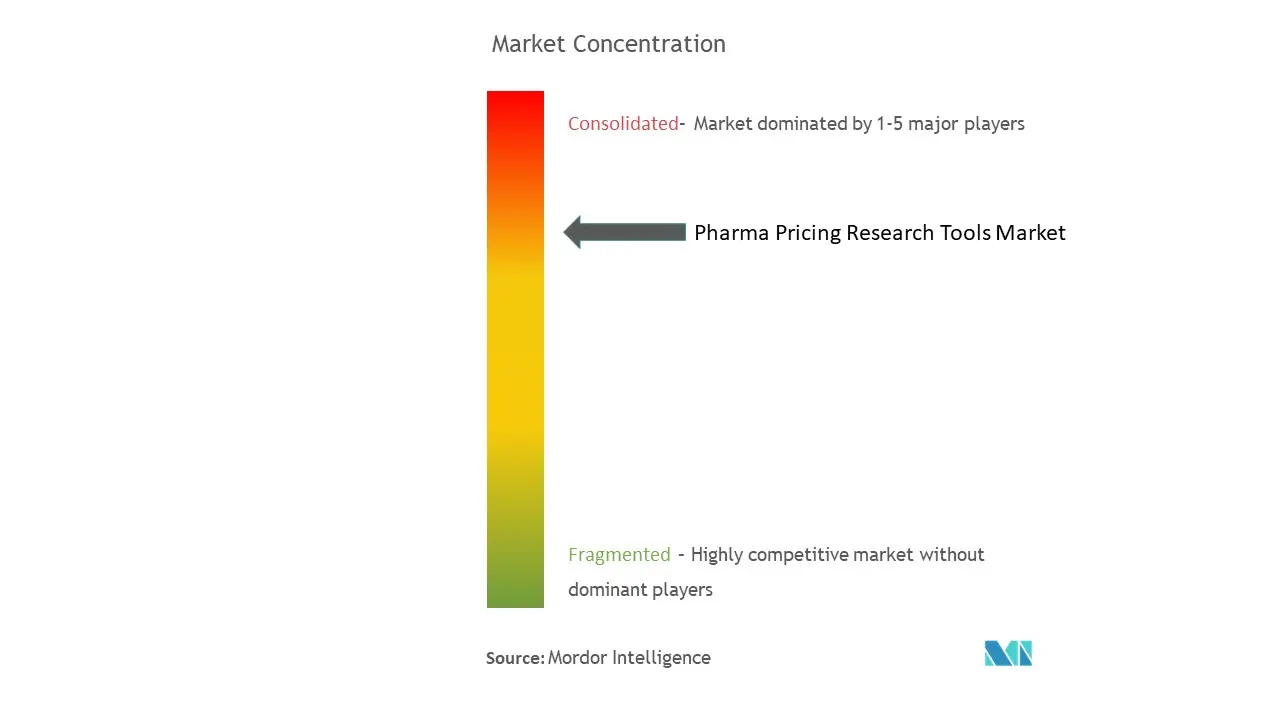Pharma Pricing Research Tools Market Analysis
The Pharma Pricing Research Tools Market size is estimated at USD 1.72 billion in 2025, and is expected to reach USD 2.17 billion by 2030, at a CAGR of 4.8% during the forecast period (2025-2030).
The rising demand for the complexity of pharmaceutical pricing and the growing adoption of value-based pricing is expected to boost market expansion for the pharma pricing research tools market. The pharmaceutical industry has seen a steady increase in the complexity of drug pricing and value-based pricing-related challenges. Moving away from traditional cost-based pricing, pharmaceutical companies are increasingly adopting value-based pricing models. This considers the clinical and economic value a drug delivers to patients and healthcare systems, including variable pricing across markets, and these prices depend on specific patient populations, healthcare systems, and willingness to pay. Brand-name drug prices have been increasing faster than the rate of general inflation for decades, and drug companies have increasingly relied on such price increases for revenue growth. For instance, the data published by the AARP Public Policy Institute in August 2023 shows that more than half the current list prices of the top 25 drugs have hiked since their initial release in the United States. Thus, this creates a complex pricing landscape for pharmaceuticals. The increasing price hikes of top drugs fuel the demand for pharma pricing research tools. These tools empower manufacturers to navigate the complex pricing environment and make informed decisions that will be anticipated to drive the market's growth in the forecast period.
Furthermore, value-based pricing (VBP) shifts the focus from production cost to demonstrating drug value improved patient outcomes, cost saving, and societal benefits. Pricing research tools help collect and analyze data on this aspect, creating an evidence-based value proposition. Companies need tools to measure and quantify the value of their drugs (increase lifespan cost savings). Based on proven value evidence, value-based pricing (VBP) generates data-driven reports to support negotiations with payers. For instance, in an article published by JAMA Health Forum in December 2022, value-based pricing (VBP) successfully met cost-effectiveness benchmarks, with prices reflecting the value delivered in terms of quality-adjusted life-year gained, staying below USD 100,000 and USD 150,000 per Quality-Adjusted Life-Year (QALY). Manufacturers' focus on value-based pricing increased the demand for the pharma pricing research tools market over the study period.
Due to the aforementioned factors, such as the increasing demand for the complexity of pharmaceutical pricing and the rising adoption of value-based pricing, the market is expected to continue to grow in the coming years.
However, in underdeveloped countries, the lack of standardization in various aspects of healthcare data and hurdles in the adoption and effectiveness of pharma pricing research tools will hinder the market growth in the forecast period.
Pharma Pricing Research Tools Market Trends
The Over-the-Counter Segment is Expected to Show Healthy Growth Over the Forecast Period
Over-the-counter (OTC) medications are more convenient to procure than prescription drugs because of their affordability, ease of production, and lenient regulatory scenarios. This makes them more attractive for early-stage research and testing of pricing strategies. Most people generally opted OTC drugs due to their less expensive and easy affordability. For instance, according to data published by KFF's Health Tracking in January 2023, 85% of adults reported using healthcare insurance to pay for their prescription drugs, and 1 in 5 adults reported difficulty affording needed prescription medicines. This approach leads to the demand for OTC drugs, further boosting the demand for the pharma pricing research tools market in the forecast period.
Over-the-counter drugs are readily available in the market, and direct consumer feedback on pricing sensitivity allows pharmaceutical companies to evaluate the different pricing models in real-time and adjust their strategies accordingly. Increasing pressure for pricing transparency from regulators and consumers requires companies to justify their OTC pricing strategies, further highlighting the need for robust research tools. For instance, according to European Union Law in October 2023, EMIR establishes regulations for over-the-counter (OTC) derivative contracts, central counterparties (CCPs), and trade repositories, aligning with G20 commitments made in Pittsburgh, United States. Increased pressure on drug manufacturers to comply with complex and involving pricing regulations creates a demand for specialized tools and expertise that will further increase the market expansion in the forecast period.
Emerging technologies like AI and big data analytics are transforming the OTC pricing landscape. Companies utilize these tools to gain deeper insights and make more informed pricing decisions. For instance, according to DataToBiz, in May 2023, statistics show that the pharma industry will spend around USD 3 billion on AI in drug discovery by 2025. These tools can provide valuable insights into consumer behavior, competitor pricing, and market trends, helping manufacturers make informed pricing decisions. These emerging technologies to develop software will expand the market in the forecast period.
Hence, market forces like rising price sensitivity and AI-driven analytics are expected to continue to grow in the coming years.
North America is Expected to Show Significant Share in the Market Over the Forecast Period
North America is expected to hold a significant market due to rising R&D expenditure, high drug cost burden, and strict regulations. North American pharmaceutical companies invest heavily in R&D, leading to frequent drug launches and complex pricing considerations. Research tools are crucial for managing diverse pricing strategies across various drugs. Additionally, North America has stringent regulations around pharmaceutical pricing and drug marketing. Regulations promoting value-based pricing, where reimbursement is linked to therapeutic outcomes, require robust analytics to assess real-world effectiveness and cost-effectiveness. This fuels the demand for advanced pricing research tools.
Companies require advanced research tools to navigate these complexities and ensure compliance with legal requirements. Regulatory bodies in North America increasingly emphasize pricing transparency, necessitating robust research tools for companies to analyze, justify, and communicate their pricing strategies. The United States drug pricing and reimbursement are undergoing significant changes, with federal legislation and the prescription drug pricing reform provisions of the Inflation Reduction Act significantly altering the pricing regime under certain federal programs. For instance, in an article published by Pharmacy Journal (MDPI) in October 2023, the Inflation Reduction Act of 2022 (IRA) poses a significant challenge to the profitability of select drugs for United States pharmaceutical companies. The act empowers Medicare to negotiate prices directly and mandates rebates for excessive price increases, compressing profit margins on affected products. The IRA includes provisions that aim to lower medicare drug prices, including allowing negotiations for certain high-cost drugs and certain high-cost drugs and requiring manufacturers to deduct excessive price increases. The law allows Medicare to negotiate prices on selected drugs and requires pharmaceutical companies to rebate price increases exceeding inflation. Hence, IRA's price negotiation and inflation rebates introduce complexities in drug pricing. This, in turn, fuels the demand for pharma pricing research tools. These tools become crucial for navigating the new landscape and making informed decisions about drug costs.
Canadians are struggling to afford medications due to high drug prices. This puts pressure on the healthcare system. Pharma pricing research tools can help find more affordable treatment options. This raises demand for transparency and fairer pricing, putting pressure on manufacturers to justify their pricing decisions. Government agencies like the Patented Medicine Prices Review Board (PMPRB) are implementing stricter regulations and price controls to address public concerns. For instance, in data published by the Government of Canada in May 2023, Prince Edward Island (PEI) expanded its provincial drug coverage to reduce copays for almost 60% of medications regularly used by Island residents and increase access to the provincial High-Cost Drug Program. This program reduces copays for commonly prescribed, eligible medications to USD 5 for residents covered under the seniors drug, the family health benefit, as well as the generic drug and diabetes drug programs. This includes medications used to manage mental health, cardiovascular disease, and diabetes and represents about 60% of prescriptions that Island residents use regularly. The rising cost burden of the drug class creates a complex situation for pharma companies, which will further need specialized pricing tools to lower drug prices and increase the market's growth.
Therefore, the aforementioned factors, like the rising cost of drugs and strict regulations by the government for drug approval in the market, are anticipated to fuel the market's growth over the forecast period.
Pharma Pricing Research Tools Industry Overview
The pharma pricing research tools market is moderately consolidated in nature due to the presence of limited companies operating globally as well as regionally. The competitive landscape includes an analysis of international and local companies that focus on the pricing tools for different drugs and an analysis of the pricing of drugs to expand their presence in the global market. The pharma pricing research tools companies include IQVIA, Clarivate Analytics, Phamax, Wolters Kluwer N.V., Veeva Systems, Avalere Health, LLC, Inpharmation, Elsevier, and others.
Pharma Pricing Research Tools Market Leaders
-
IQVIA
-
Clarivate Anlaytics
-
phamax
-
Wolters Kluwer N.V.
-
Avalere Health, LLC
- *Disclaimer: Major Players sorted in no particular order
Pharma Pricing Research Tools Market News
• In February 2024, The United States Department of Health and Human Services (HHS), through the Centers for Medicare & Medicaid Services (CMS), revealed the first 10 drugs that will be subject to price negotiations under Medicare Part D. These negotiations will take place in 2023 and 2024, and any resulting price reductions will go into effect in 2026.
• In December 2023, Biosimilar versions of Enbrel were on the waiting period for the resolution of patent litigation, which is expected to lead to lower costs or cost savings upon their market entry. Despite the approval of two etanercept (Enbrel) biosimilars in the United States, neither has yet been launched due to ongoing patent litigation. This legal battle is expected to keep the biosimilars off the market until 2029.
Pharma Pricing Research Tools Industry Segmentation
As per the scope of the report, pharma pricing research tools are specialized software applications or databases that help pharmaceutical companies gather and analyze data to inform their pricing decisions. The pharma pricing research tools market is segmented by application, type, and geography. By application, the market is segmented into prescription drugs and over-the-counter drugs. By type, the market is segmented into market-based, value-based, and cost-based pricing. The market is segmented by geography into North America, Europe, and the Rest of the World. The report offers the value (in USD) for the above segments.
| By Application | Prescription Drugs | ||
| Over-the-counter Drugs | |||
| By Type | Market-Based Pricing | ||
| Value-Based Pricing | |||
| Cost-based pricing | |||
| Geography | North America | United States | |
| Canada | |||
| Mexico | |||
| Europe | Germany | ||
| United Kingdom | |||
| France | |||
| Italy | |||
| Spain | |||
| Rest of Europe | |||
| Rest of the World | |||
Pharma Pricing Research Tools Market Research FAQs
How big is the Pharma Pricing Research Tools Market?
The Pharma Pricing Research Tools Market size is expected to reach USD 1.72 billion in 2025 and grow at a CAGR of 4.80% to reach USD 2.17 billion by 2030.
What is the current Pharma Pricing Research Tools Market size?
In 2025, the Pharma Pricing Research Tools Market size is expected to reach USD 1.72 billion.
Who are the key players in Pharma Pricing Research Tools Market?
IQVIA, Clarivate Anlaytics, phamax, Wolters Kluwer N.V. and Avalere Health, LLC are the major companies operating in the Pharma Pricing Research Tools Market.
Which is the fastest growing region in Pharma Pricing Research Tools Market?
Europe is estimated to grow at the highest CAGR over the forecast period (2025-2030).
Which region has the biggest share in Pharma Pricing Research Tools Market?
In 2025, the North America accounts for the largest market share in Pharma Pricing Research Tools Market.
What years does this Pharma Pricing Research Tools Market cover, and what was the market size in 2024?
In 2024, the Pharma Pricing Research Tools Market size was estimated at USD 1.64 billion. The report covers the Pharma Pricing Research Tools Market historical market size for years: 2021, 2022, 2023 and 2024. The report also forecasts the Pharma Pricing Research Tools Market size for years: 2025, 2026, 2027, 2028, 2029 and 2030.
Our Best Selling Reports
Pharma Pricing Research Tools Industry Report
Statistics for the 2025 Pharma Pricing Research Tools market share, size and revenue growth rate, created by Mordor Intelligence™ Industry Reports. Pharma Pricing Research Tools analysis includes a market forecast outlook for 2025 to 2030 and historical overview. Get a sample of this industry analysis as a free report PDF download.

